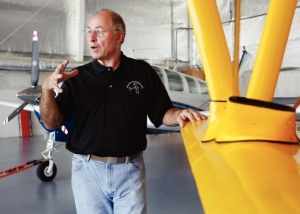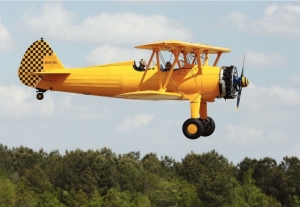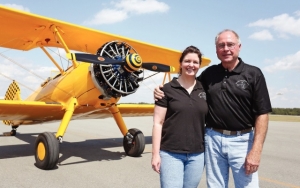A life in flight
By Melinda Harrell
Published in News on May 9, 2016 1:46 PM

News-Argus/CASEY MOZINGO
Gene Taylor talks about the how his 1940 Stearman biplane differs from today's airplanes in his hangar at the Wayne Executive Jetport. The wings are wood wrapped in fabric, the fuselage is metal, and the radial engine is loud. He said, "It's kind of like a Harley, when you hear it you know what it is."

News-Argus/CASEY MOZINGO
Gene Taylor does a low pass over the runway at the Wayne Executive Jetport.

News-Argus/CASEY MOZINGO
Karen and Gene Taylor stand in front of their 1940 Stearman biplane at the Wayne Executive Jetport.
The pilot was telling Gene Taylor that they were going to die.
The two-seat plane was in a stall spin heading into the mountains of southern Kentucky.
It was 1966, and the 20-year-old Ohio State University student had been skydiving for five or six months before the Ohio winter had begun to set in, hampering his jumps.
"My instructor had got his pilots license, and he bought a two-seat airplane," Taylor said.
"He was grumbling about how we ought to go together to Nassau and spend a month down there and do some jumps and pay for a month's vacation. I said, 'I'm in.'"
The next day, the two were headed down south, but the flight and the plans would quickly go awry.
The oil gauge began to show signs of fluctuation in the northern part of Kentucky.
"We got into Kentucky and the oil pressure gauge started fluctuating, which is an emergency," Taylor said.
"If you don't have any oil, the engine will seize up, and you have to find somewhere to land it."
The pilot landed the plane on an airstrip and the mechanic there took a look at the plane -- it appeared to be only a loose oil cap.
They were back in the sky before the end of the day. Taylor had never flown a plane at the time, he had only "just jumped out of them," and as they were flying farther south, closer to the mountains of southern Kentucky and northern Tennessee, his eyes were constantly on the oil gauge.
"Now I know what that gauge does, and I am glued to that gauge," Taylor said.
"And we are cruising through the hills and all of a sudden the gauge went (out) and I said, 'Hey, gauge, gauge.' Oil starts coming out on the windshield. I mean oil everywhere. It could have been a minute or so, and the engine just locked up. I am looking down there and there was nothing flat."
The pilot tells Taylor that they were going to survey the terrain and find a place in the valley to land.
It did not work out that way. The pilot never turned around to land through the valley, opting to take a left.
Taylor said the turn led to a dead end. The pilot "rolled the plane over steep" to avoid the mountain, but he was too slow. The plane basically "quit flying."
"As we were spinning, I see this red barn going by, and it was classic slow motion," Taylor said.
"Like tunnel vision, and I could hear the engine whining up going faster and faster. But it wasn't coordinating with the slow turn, and I thought this really doesn't make sense. We were going straight down. (The pilot) says, 'We're going to die,' and I said, 'Yeah, I know.'"
As the plane was careening out of control, Taylor recalled an obscure memory from when he was a boy.
"I remembered from kindergarten the teacher had us stand on chairs and jump off, and saying, 'Relax instead of being stiff, and you will land easier,'" Taylor said.
"And I'm thinking, I'll give that a try. I take a real deep breath, and I exhale as soon as we were going to impact."
Taylor said that a simple lesson from kindergarten was what saved his life.
He was hospitalized and confined to a back brace as well as suffering from "facial stuff."
Taylor's injuries were mild compared to the pilot's who was put in intensive care. The pilot underwent extensive operations and massive facial reconstruction surgery as well as losing an eye, but none of the efforts would save his life, Taylor said.
"Long story short, he had a blood clot come loose," Taylor said as he paused for a moment, remembering his old friend, "and they couldn't save him. He lived for about a month."
That would be the end of many people's flying adventures. Death had come incredibly close to Taylor.
But, instead of living in a cloud of fear, Taylor opened his arms and embraced it -- he got a pilot's license.
"I decided next time I get in an airplane I am going to have a parachute on, and I am going to be the one flying," Taylor said with a big grin.
"The next year, I took flying lessons."
In the years since he got his license, Taylor has spent his life in the sky, and has loved every moment of it -- from piloting to aircraft mechanic work to skydiving.
He has accumulated 20,000 flight hours in his career. He has an Airline Transport Pilots License, is flight instructor and has an FAA Airframe and Powerplane Mechanics License.
Taylor has owned a parachuting business in Ohio where he became a plane mechanic to maintain his equipment while running the business. He became one of the first tandem skydiving instructors in Ohio. The parachuting business also brought him to his wife, Karen.
"The fun thing is, I kept throwing her out of this airplane, and she kept coming back, she's a keeper," he said with a laugh.
They moved down to Texas to be a corporate pilot, and then they moved to North Carolina to be closer to family.
Now he is at the Wayne Executive Jetport where he and Karen run a plane maintenance business out of a hangar, Omni Aircraft Service.
In that same hangar sits their 1940 Stearman biplane.
Of course, it would only be natural for Taylor to own one of the nearly 1,000 Stearmans in existence that still flies. Its top-heavy design, thunderous motor and open-air cockpit suits Taylor and his need to be in the sky with as few barriers as possible.
Taylor offers rides on the bright yellow-orange Stearman through their company, Barnstormer Flights.
"Gene has flown for 49 years now, and he had a friend, years and years ago that had a Stearman, and he asked Gene to maintain it to make sure it runs properly, and Gene, being a mechanic, worked on it," Karen said.
"So he had a soft spot in his heart for this particular kind of airplane. He has flown everything from little ultralights to helicopters to jets, and there was something special about this one because he had friends that had flown them, he took care of them and jumped out of them. It took months and months and a lot of hunting to come across this airplane."
As he cranks the motor he says, "Sounds just like a Harley," and laughs.
Taylor's laugh is one of satisfaction and no regret.
"It seems to me, hearing his stories and stuff, that Gene is still trying to figure out what he wants to do when he grows up," Karen said.
"He did all this stuff for fun. And he is like, 'I get to fly,' that was fun for him. He gets to skydive, that was fun for him. And he somehow gets to make a living out of it all these years."
Taylor agrees with his wife, "I have had a fun life," he said with a grin that never quite leaves his face.
